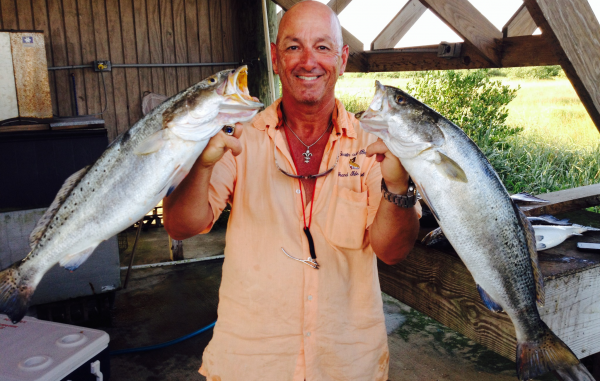
Vidrine shares his thoughts on hooks, hook setting and live bait
Tommy Vidrine was back hard at it in Grand Isle yesterday and this morning, hauling in more 4- to 5-pound lunker trout like most folks catch 14-inch schoolies.
In fact, while I was writing this story, he texted me to let me know he was fishing along Fourchon beach with live pogeys and caught a 6-pounder earlier today.
Vidrine, who splits his time between his home in Baton Rouge and his camp at Grand Isle, recently shared several of his tips and tactics to catch big specks with LouisianaSportsman.com.
In the last article, he discussed proper use of a trolling motor and good anchoring techniques.
Today, he shares his thoughts on the hooks he uses, how he sets the hook on big trout and how he rigs up live bait.
Use the right hooks for the right bait
Vidrine’s hook of choice for fishing with live shrimp is a 2/0 circle hook.
If he’s using live croakers, he switches to a 4/0 Kahle hook because it’s bigger and wider and gets through the ‘meat’ of the croaker when he sets it.
“There’s no need for any bigger hooks in a trout box,” Vidrine said.
When fishing with croakers, Vidrine believes many anglers lose trout by not letting the trout take the bait.
In strong current, he hooks the fish through the lips. With slack current, he hooks them through the back for more action.
“I press my spool button when I feel a good hit, and I’ll let them go 4, 5 or 6 feet, and I’ll click it and I’ll give it a nice smooth hook set with that Kahle hook,” he said. “Most people pull it out their mouth.”
He often advises people on his boat to keep their left hand in their pocket while fishing.
“Just hold it with your right hand,” he said. “When they do that, the trout hooks himself. They’re not going to let that shrimp or croaker go.”
And with the circle hook, too often he sees excited anglers set it hard and end up losing fish.
“Just lift and reel. You don’t have to set the hook,” Vidrine said. “When he’s pulling away from you, you’re just pulling the opposite way. Lift up on the tip and reel down — it’s done.
“It’s hooked. You’ve got the right hook on. He’s not going to open his mouth and when the circle hook sets, you’ve got him.”
Another reason he likes the 2/0 circle hook is because his shrimp stay alive longer. Vidrine hooks them through the head right under the horn.
But at the end of the day, when smaller shrimp are usually all that’s left in the livewell, he switches it up and hooks them through the last link in the tail.
“If you’ve got a little bitty small shrimp, the head will be so small when you put that hook in them it’s likely going to kill them in the first 20 seconds, and then you’re fishing with a dead shrimp,” Vidrine said. “Now you might catch a hard head or a sheepshead instead of a trout.
“So if all you can get is small shrimp, I’d hook them through the tail because they’ll stay alive much longer.”
In the next article in the series, Vidrine discusses casting placement in relation to the structure you’re fishing.


